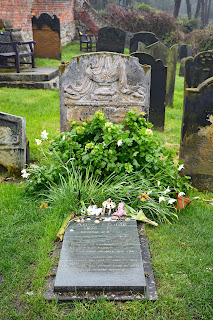Northern Road Trip: Day 2 – Scarborough, Whitby, Durham, and the Moors
The cake we bought yesterday was very good, and it served as breakfast this morning as we were too full to eat it after consuming the ice cream that had come with it. Leaving our exploration of York for another day, we departed for Scarborough, a seaside town most famous for the song Scarborough Fair. As Johnny discovered on Wikipedia on our way, the celebrated fair had a 500-year tradition until it was discontinued in the 19th century. Also, the town itself was destroyed or heavily damaged multiple times: first by the Vikings, then during the Civil War, and finally by the Germans during the Second World War.
We found Scarborough to
be a quaint town whose weather did not do it justice. We parked in the middle
of the peninsula towards the top of the hill on which Scarborough Castle
stands, but it was so misty we hardly saw the castle. Foregoing the views from
the castle, which we figured would be non-existent, we visited the heavily
dilapidated and practically illegible grave of Anne Brontë. On the flower-flanked
plaque that lies in front of it is an inscription that points out the original
writing on the tombstone mistakenly claimed the author had died at the age of
28, when in fact she had been 29.
From the hill, we
descended to walk along the seaside and visit the historic old town. The
seaside seemed quite pleasant, with numerous shops selling coastal British
classics like toffee, candy floss, and hot dogs. There were also multiple
flashy casinos. Even in the misty weather, the town beach was beset by a swarm
of dogwalkers, who heeded but little the many signs prohibiting dog walking on
several sections of the beach. We also saw a treasure hunter with a metal
detector and wondered whether he dug up much dog poo on his exploits.
From Scarborough, we
continued to Whitby, the hallowed resting place of Caedmon. As the first
recorded English poem, Caedmon’s Hymn was an important component on Roberta
Frank’s reading list at Yale, and our whole class had to memorise the famous
lines (all I can remember now are a few snippets beginning with “Nu we sculon
heorigan”). In Caedmon’s memory, Whitby has erected a cross depicting the poet
as well as a few religious figures, all presided over by a carving of Jesus.
The fog had become
very thick by then, so much so that we struggled to find Whitby Abbey from the
car park. That being the case, we decided to have lunch and wait for the fog to
clear up. Descending through the picturesque and bustling tourist town, we followed
Xiaohongshu (a Chinese app that tends to be quite reliable when it comes to
food recommendations) to find a good seafood restaurant. Our gamble paid off:
as we left the restaurant, it began to rain and the fog subsided. We visited the
ruins of Whitby Abbey, leaving soon after.
Our final major stop
of the day was Durham. One of the northernmost towns in England, Durham prides
itself on being the historic bulwark against Scotland, though I am not sure
this boast carries as much weight now as it did a few hundred years ago. Durham
Cathedral is also the resting place of two major English figures: Saint
Cuthbert and Bede.
Saint Cuthbert is
perhaps the most important saint of North England and is frequently depicted
holding the head of Saint Oswald. Legend has it that when their remains were
unearthed, they showed no sign of deterioration, which strengthened Cuthbert’s
cult. Indeed, it was probably due to this fact that Cuthbert’s remains
weathered Henry VIII’s iconoclastic ravage of England, and rest at the
cathedral to this day. As for Bede, he was an important scholar who left behind
some of the earliest records of English history.
After visiting Durham
Cathedral, we realised we had just enough time – and were lucky enough to buy
two of the last remaining four tickets – to catch the last tour of Durham
Castle. The site cannot be entered in any other way, for it serves as one of
Durham University’s residential colleges, and the institution understandably
does not want it to transform into a tourist thoroughfare. Our guide (a smartly
dressed undergraduate at the university) took us through the courtyard, chapel,
the black staircase, and the dining hall.
As we drove back to
York, the weather suddenly cleared up. It was so surprising and fantastical
after many days of rain and fog that we simply had to make use of it.
Originally, I had planned to visit North York Moors National Park before Durham
but decided against it because of the weather. Now, it was nice enough to go.
Hanging a left at Darlington, we approached a jagged peak at the very north end
of the park called Roseberry Topping.
We parked the car under Cook’s Monument but seeing how far away the peak seemed from the car park, we climbed the opposite hill instead. In retrospect, we probably should have tried to climb to Cook’s Monument, as the views of Roseberry Topping from our hill were not great. Nevertheless, we saw a beautiful expanse of moors on the opposite side of Roseberry Topping, which changed colours as the clouds shifted and the sun sank.
























































Comments
Post a Comment